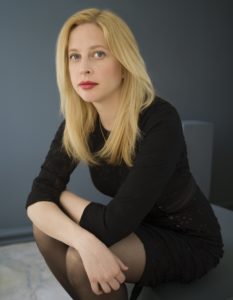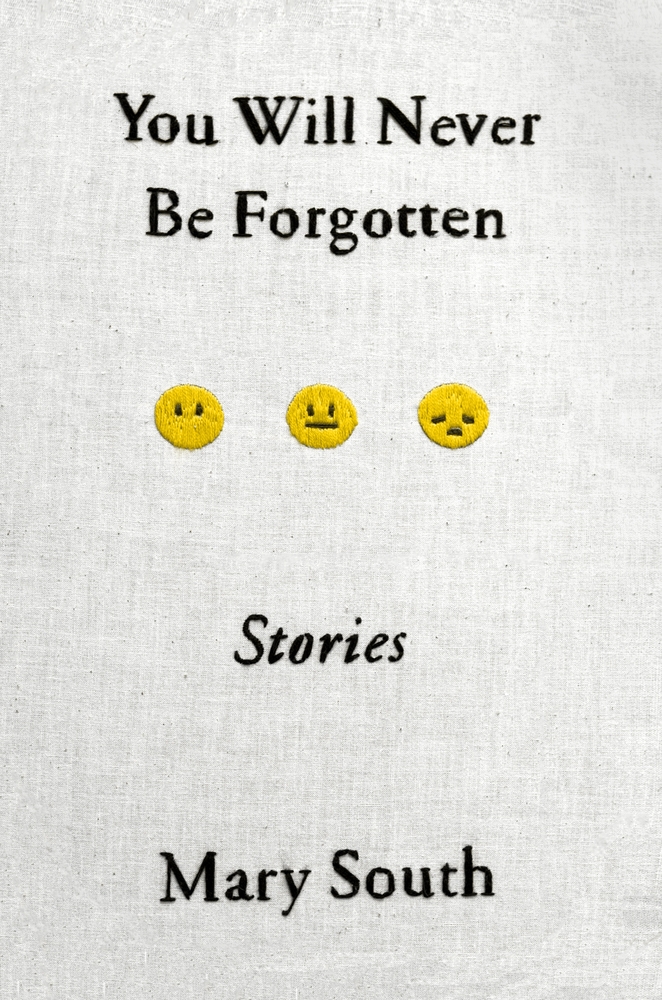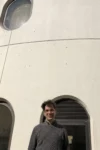
© Nina Subin
Mary South stares into the dark of the digital age, and that dark stares back. The stories in You Will Never Be Forgotten are fearless examinations of human (dis)connection in the age of virtual hyperconnectivity—of our cultural moment where the culture has passed us by, where the map may have overtaken the territory. Each of South’s stories ache for connection and understanding where there is none, with deeply felt characters and precise language leading us to a portrait of our times that is disturbing for its accuracy and, in places, its clairvoyance. Mary South is the author-cartographer I would take with me to map our wreckage in late capitalism.
Kyle Williams: I was struck throughout this collection by how contemporary these stories are, or how hyper-contemporary they are. Two of the stories address content moderation in the age of hate memes, for instance. Was it a challenge to write stories engaging in those areas of culture?
Mary South: Writing about the darker side of our collective relationship to the internet was a challenge at times because, if I was going to go there, it was important to me that I didn’t look away from the worst of it, yet I also didn’t want to traumatize (or retraumatize) the reader. My aim was to make art that fully critiques contemporary experiences without glorifying them or overly emphasizing how upsetting they can be. Moreover, I didn’t want my stories to become “all premise.” I really want to be complex and nuanced, which is hard to do when it comes to the internet, to avoid the kind of reductive thinking along the lines of, “Here’s a story about how social media makes us judgmental and kills empathy” or “Here is a story about how no one has any real privacy anymore.” Yes, there is that element to them, but a premise does not make a story. How I decided to end up navigating some of these tricky balances was to just describe as clearly and succinctly as possible the technological aspects when I had to (e.g., what the job of a content moderator entails) and then to ground the story in the character’s emotions. Ultimately, technology is just a tool; it’s not inherently good or bad. By shaping the story around how a character is using technology to self-soothe in detrimental ways or avoid negative feelings, I hope I keep these stories human, leaning toward meaning. I also tried to give the reader a “break” by how I structured the collection, placing a lighter, more humorous piece after a more bleak story. That’s why “Camp Jabberwocky for Recovering Internet Trolls” follows the title story about a woman still processing her sexual assault. After sitting with the intensity of “You Will Never Be Forgotten,” the reader can enjoy a more tender caper story.
What was the research process like for the stories engaging in the hyper-contemporary? “Camp Jabberwocky” and “To Save the Universe” strike me as particularly in-depth studies, and they are studies of just how gruesome the internet age can be. How far into the dark did you go in your research?
First off, I’ll say it’s very interesting to me, and a little terrifying, how these stories have become even more of the moment as time has gone on, not less. I originally feared that they would become “dated.” The internet moves fast, and publishing a book is a much slower process. The title story, for instance, I wrote at the end of 2015. Thus, it was created before both the presidential election and the #MeToo movement. Content moderation has also continued to be increasingly problematic, with more and more articles appearing in places like The Verge about how damaging it is for the people who perform those jobs. Around the time I was writing the title story, I also read a piece in the New York Times about a Russian troll farm and the havoc it wreaks in the States, fabricating disasters and vitriol, simply titled “The Agency.” Of course, this was before I knew about their meddling in our politics. I don’t think any of this is a testimony to my prescience; rather, issues that have been long extant are finally getting publicly examined. Women have been navigating how to live within a misogynistic society this entire time. I’m relieved our experiences are at last getting acknowledged. However, it’s disturbing to see the internet become a more and more concentrated version of itself. How does that influence our psychology? Does it create feedback loops? Do we become more concentrated versions of ourselves?
As for the research, while I did read and investigate a lot, as you can likely tell from the above, I stopped from going so far as to actually track down footage that a content moderator might have to screen. I didn’t think I’d be able to handle viewing those videos. Nor did I delve into the dark side of message boards that spew hatred; I didn’t think I’d be able to handle that, either. But a lot of what’s enraging about the internet is also simply out in the open. I’ve had a friend get “doxxed” and have to completely lock down her life and delete all of her social media accounts. I’ve watched the internet go after public figures on social media and bully them out of online spaces. What happened to Star Wars actress Kelly Marie Tran was so wrong and horrible. I don’t want to let these things just glide by; I think we can learn from our current digital age through art and being in conversation with it. There’s something that’s at least cathartic about depicting our times fictionally. For me, it takes some of the powerlessness or passivity out of being an observer.
The grotesque is a constant figure throughout the collection. Taboo, violent, brutal behavior abound. The stories disturb—which is, I think, a testament to your ability as a writer. What draws you toward that subject matter? You wrote somewhere that fiction is not an anodyne in difficult times—could you say more about that?
Lately, while we’ve been in the middle of a pandemic, I’ve been hearing a lot of mention of reading as an “escape” of the present moment, even reading lists to that effect. Funnily enough, there’s also been lists to the opposite effect, rounding up novels about viral outbreaks. We really all gravitate toward reading for different reasons. While I empathize with those who want an escape right now, that’s a totally valid response, my impulse is usually to go deeper in. It’s hard to say what the goal of art is; should art be mimetic of our lives? Didactic in terms of teaching us how to build a better self, a better world? I’m not sure I know what it’s for, only that when I read I feel like it orders my experience in a way that nothing else ever has—not religion, not even philosophy. I also still believe, perhaps naïvely, that art can bring about social change, one person at a time. But I’m not sure how it can do that without looking head on at what can turn us ugly, selfish, grotesque. On the flip side of our various grotesques, I also believe that most people are good, mean to do good, and that they turn ugly because they’ve been wounded and are trying to cope with the wound or avoid re-experiencing pain. They’re being protective, in a sense. The question follows for me, then: How can I break them open fictionally, reveal the pain they’re afraid to confront and show them that better coping is possible? It’s not an “epiphany” that my characters experience at the end of a story per se, but discovering the long process of re-learning how to be.
The setup of “Keith Prime” is interesting in contrast to the stories that are hyper-contemporary, taking place in a dystopian but not unreal future. What brought you to make that speculative jump for that story?
It’s funny, though it’s the most speculative of all the stories, “Keith Prime” often feels the most real to me! I was originally led to write the story by two things: the first is Kazuo Ishiguro’s Never Let Me Go, one of my all-time favorite novels, and the second is my horror at how late capitalism treats gig economy workers—particularly warehouse employees at Amazon. Never Let Me Go trains its focus mostly on the clones, growing up as children in their specialized boarding school and later beginning their “donations,” rather than on the bureaucracy that created them and the doctors and nurses who harvest them for parts. I was always interested in learning more about that aspect of the novel, those who are complicit in the system. I wondered if I could explore it myself. I’m also interested in how Ishiguro manages the indoctrination of his characters into reality. Neither his clone characters nor the “regular” people who believe them to be soulless bodies question if what they’re doing is acceptable, yet we, as readers, are horrified. But he’s so smart about it, of course—he indoctrinates us as readers, too, not revealing exactly what’s happening until we’re already well immersed in the world of the novel. It’s illustrative to me of how we get used to the circumstances of our own lives, and quickly. Look at how much of late capitalism and gig economy work is just accepted as “how it is” or “part of doing business.” Amazon warehouse employees are tracked, optimized, and penalized if they’re not efficient enough. They don’t even have time to pee. How can we regard some people as disposable and exploitable and others not? So I decided to follow Ishiguro’s example with a bit of a speculative jump to show just how much we take for granted that we shouldn’t. As a friend said, “Keith Prime” is Never Let Me Go meets free, two-day shipping.
The collection freely references writers like Lewis Carroll, Rimbaud, James Joyce, Mary Shelley. I think I can spot E. M. Cioron in “Keith Prime,” and in its frame as an academic study “Architecture for Monsters” makes many nods toward ideological forebears, like Gertrude Stein. Do you see writing fiction as a way to engage with and work through the ideas of writers and thinkers? Or, Do you see your fiction as driven by the ideology and criticism of writers before you?
There’s a great pleasure for me in engaging with the writers who have come before me. I think it’s important for us to read as much as we can, incorporate into our understanding the craft of our predecessors, then create new, innovative works that speak to life now without ignoring the fact that we are part of a tradition. I also just believe in going where the pleasure is, in writing. If the writer is enjoying herself while working on something, it’s often a good sign the reader will enjoy it, too. I’m someone who delights in facts, random pieces of knowledge, quotations, references to films and visual art, so I put that into my stories. I have documents hundreds of pages long filled with facts, anecdotes, witticisms. I also find a lot of pleasure in getting stories to talk to each other or offering small Easter Egg moments to the reader. There are two Gertrude Stein references in the collection, one in “Architecture for Monsters” and another in the title story. Those put them in secret conversation, in my mind, and for the reader too, if it’s spotted. In “Realtor to the Damned” the protagonist is trying to sell a house filled with oil paintings of women reclining on teeth, and he and his wife propose names for one of them, all of which were the names of famous female Surrealist painters. That’s so fun, I think, if the reader picks up on that. The quotation is:
“The paintings were donated to charity, except for the one we kept—our favorite redhead in a red bikini. She hung over our sectional and made an excellent conversation piece for guests. We proposed names: Leonora, Gertrude, Remedios, Sylvia, Eileen. Nothing stuck, so we ended up referring to her as Portrait of a Woman with Second Molar.”
That’s Leonora Carrington, Gertrude Abercrombie, Remedios Varo, Sylvia Fein, and Eileen Agar. There’s something really fulfilling to me about creating a rich intertextuality or a world of references that mimics the richness in life itself.
If we can focus on just one reference: Can you say more about Gertrude Stein? What draws you to her work, and keeps you going to it?
I’m almost drawn to Stein more as a literary figure. She became this iconic woman of power. And she wasn’t modest about it—she knew she was important, that she wanted to be important, so she self-actualized herself into importance. I love that. I love the salons she organized. I love the long relationship with Alice B. Toklas. But I’m an admirer of her work, too. I’m drafting a novel next about women who are transforming into household objects, and Tender Buttons is a wonderful text to review for its ability to make objects newly strange, how it uses language to defamiliarize the quotidian. I can’t say I understand it all the time or even half the time, but I like the way sentences and phrases in it can ping against my mind somehow, prompt me to want to write. I could think on this lovely observation for an afternoon, “A lamp is not the only sign of glass.” I’m enchanted simply by the section titles: The Substance in a Cushion, Mildred’s Umbrella, Roast Beef. Here’s one of my favorite brief sections:
A METHOD OF A CLOAK. A single climb to a line, a straight exchange to a cane, a desperate adventure and courage and a clock, all this which is a system, which has feeling, which has resignation and success, all makes an attractive black silver.
Of course, cloaks have always been sexy, but what a way to reconceptualize one. “Resignation and success.” And there’s some great syllabic work in there, in assonance, “climb to a line” and “exchange” and “cane” with their long a’s. I also appreciate that it ends concretely, with the color of fabric. That’s compelling and smart work.
This might sound strange, but I was surprised by how plotted these stories were. Maybe this reflects more on me than you, but I feel like plot is often put to the side by writers as interested in language as you are, and there is a certain celebration for plotlessness in literary culture at large. Do you feel like that’s the case? How do you see plot as a function of language?
I studied with Gordon Lish, and his method of consecution is well known. Gary Lutz writes about it brilliantly in his now famous craft-talk-turned-essay, “The Sentence Is a Lonely Place.” I very much believe in this method, of carrying an initial set of sounds forward through the sentence, the paragraph, the whole story. I want my prose to be torqued and strange. The story in my collection that perhaps most strives to achieve excellence in consecution is “Architecture for Monsters.” There’s a lot of ‘k’ and ‘c’ sounds, especially at the beginning, which is done partly to emphasize breakage, to have sound echo theme—the architect, Helen Dannenforth, the center of the story around which the rest of it revolves, is known for her form-breaking, “ravaging” designs inspired by surgeries, clinically ruptured or interrupted anatomy, among other things, and she has also broken her family apart, in addition to being somewhat broken herself. Sound and plot can work together in that way. I also want to play and experiment with all the tools that are available to me. I want to dress up in different forms and then be able to discard them again. I want to try on different voices—a mournful voice, a bitter voice, a wry voice, a quippy, comedic voice—and not feel held to any particular one of them as “my” voice. We all contain a multitude of voices; how we think when we’re grieving is different than how we think when we’re enraged at the news or how we are just going about the quotidian tasks of the day, looking forward to lunch. I strive for verisimilitude in that respect, to capture a range of character voices as well as the range of voices within the individual.
I love the formal innovation in “Frequently Asked Question.” It may be my favorite story in the collection. What brought you to use the FAQ format?
One of the things that fascinates me about form is how we’re surrounded by so many of them now because of how much content we consume on the internet. In any one day, we’ll read through several email chains, news articles, forum posts on a television show we’re currently bingeing, perhaps a questions-and-answers page for a medical ailment or how-to instructions on properly fixing an appliance in our homes, and more beyond that. I always wonder what it would be like to meet the consciousness (or consciousnesses) behind the content. Perhaps this is because I’ve written a lot of freelance copy for the web to make money—I’ve optimized many sites so they will rank higher in search results, I’ve composed ads for Google. I was an actual person creating some of this random or disposable internet text while at the same time writing these hyper-language-focused short stories. It was sort of disorienting at times to make the transition between the two. And I wondered if I could create fiction out of it, make slow, deliberate art out of these rapidly evolving, hyperfast forms.
The FAQ story specifically originated from looking through medical pages for reasons behind or solutions to insomnia and headaches. It can be kind of the opposite of comforting to read these pages, to be told they’re symptoms of a harrowing illness but also maybe not, maybe nothing. I again speculated about who was tasked with creating that content for money. I started mulling over whether I could sort of unravel the form itself, reveal that possible person and her struggles. The form unravels as the neurosurgeon narrator unravels, revealing her grief. But it also becomes something new by the end, similar to how grief unmakes and makes us new again. That was interesting to me to try to do.
I’d like to end by asking you about your work as an editor. You edit Noon with Diane Williams; how has that process affected your writing?
Working at NOON has been one of the most rewarding experiences of my writing life. I’m there on a more remote capacity these days, but for a while I was one of the core staffers assisting Diane Williams every week. When she was considering a story for submission, or in the intensive process of editing one, she would have us read it aloud and she would follow along with her eyes closed, lips moving to the words. She’s famously exacting; every sentence must be deemed necessary and enticing, a perfect package of idiosyncratic syntax and singing syllables. When you see someone doing that regularly, it nurtures the desire within you to do it yourself in your own work. I think I will always strive to be as exacting, as good of a sentence master as Diane Williams.

by Mary South
Farrar, Straus and Giroux / FSG Originals
Published March 10, 2020
Kyle Williams is a writer living in Brooklyn. He is an Interviews Editor for Full Stop, Director of Communications for Chicago Review of Books, and A Public Space’s 2019 Emerging Writer Fellow. He is on Twitter @kylecangogh.
This post may contain affiliate links.







